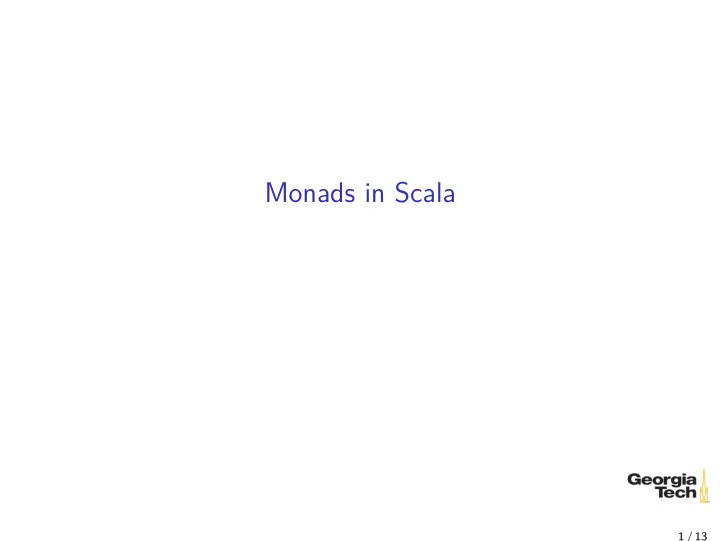

Monads in Scala 1 / 13
Functors A functor is a container type that supports map ping over its contents. 1 List is functor: 1 List(1, 2, 3).map((x: Int) => x.toString) == List("1", "2", "3") As a conceptual exercise, we could represent functor with a type: 1 trait Functor[T] { 2 def map[U](f: T => U): Functor[U] 3 } 1 Scala with Cats 2 / 13
Option Option is also a functor: 1 Some(1).map(x => x.toString) == Some(1) 2 None.map(x => x.toString) == None We usually first learn map in the context of collections. 1 List(1, 2, 3).map((x: Int) => x.toString) == List("1", "2", "3") Think of map more generally: ◮ Given a functor that contains one or more values of type A – List[A] , Option[A] , etc ◮ and a function f: A => B , map applies f to the contained value(s) to produce a container of the same type with value(s) of type B . 3 / 13
Nested Container Structure What if we have a function that transforms an A into a Container[B] for some container type? 1 def toInt(s: String): Option[Int] = { 2 try { 3 Some(s.toInt) 4 } catch { 5 case _: Throwable => None 6 } 7 } Then: 1 Some("1").map((s: String) => toInt(s)) == Some(Some(1)) 2 Some("one").map((s: String) => toInt(s)) == Some(None) 4 / 13
flatMap flatMap is like map but ◮ takes a function of the form f: A => Container[B] and ◮ removes one level of nesting. 1 Some("1").flatMap((s: String) => toInt(s)) == Some(1) 2 Some("one").flatMap((s: String) => toInt(s)) == None Again, we typically encounter flatMap in the context of collections: 1 List("RESPECT").map(_.toCharArray) == List(Array("R", "E", "S", "P", "E", "C", "T")) 2 List("RESPECT").flatMap(_.toCharArray) == List("R", "E", "S", "P", "E", "C", "T") But the concept is more general (and in the context of monads is called bind in FP/category theory). 5 / 13
Monad Definition In Scala a monad can be conceptualized in the type: 1 trait Monad[T] { 2 def flatMap[U](f: T => Monad[U]): Monad[U] 3 } 4 5 def unit[T](x: T): Monad[T] In addition, a monad must satisfy these algebraic laws: ◮ Associativity 1 m.flatMap(f).flatMap(g) == m.flatMap(x => f(x).flatMap(g)) ◮ Left unit 1 unit(x).flatMap(f) == f(x) ◮ Right unit 1 m.flatMap(unit) == m 6 / 13
Aside: Clearer Associativity It’s a bit hard to see that 1 m.flatMap(f).flatMap(g) == m.flatMap(x => f(x).flatMap(g)) is an associativity law. For monoids it was much simpler: 1 op(op(x, y), z) == op(x, op(y, z) We can use a concept from category theory called Kleisli composition to make it clearer. Kleisli arrows, i.e., monadic functions like A => F[B] : 1 def compose[A,B,C](f: A => F[B], g: B => F[C]): A => F[C] Using Kleisli composition the Monad associativity law can be written as 1 compose(compose(f, g), h) == compose(f, compose(g, h)) 7 / 13
Monads in the Scala Standard Library We already know that there are several monads in the Scala standard library, e.g.: ◮ List ◮ Set ◮ Option But there are several other types that Support map and flatMap operations, e.g.: ◮ Try ◮ Future These aren’t monads because they don’t obey all of the monad laws, so why do they bother implementing map and flatMap ? 8 / 13
Scala for Loops Recall Scala’s for construct: 1 for (i <- 1 to 5) { 2 val dub = i * 2 3 println(dub) 4 } ◮ i <- coll is a generator expression. i is a new val successively assigned values from coll in each iteration. Any container type with a foreach method can be used in the imperative for loop. These are equivalent: 1 Some(1).foreach(println) 2 for (x <- Some(1)) println(x) 9 / 13
Scala for Comprehensions Any container type with a map method can be used in a single-generator for comprehension. These are equivalent: 1 Some(1).map(_ + 1) 2 for (x <- Some(1)) yield x + 1 Any container type with a flatMap method can be used in a mulitple-generator for comprehension. These are equivalent: 1 val sum = for { 2 a <- toInt("1") 3 b <- toInt("2") 4 c <- toInt("3") 5 } yield a + b + c 6 sum == Some(6) 10 / 13
De-Sugaring for Comprehensions Scala’s for is actually syntax sugar for higher-order methods on container types. 1 for { 2 a <- toInt("1") 3 b <- toInt("2") 4 c <- toInt("3") 5 } yield a + b + c Is converted by the Scala compiler to: 1 toInt("1").flatMap(a => 2 toInt("2").flatMap(b => 3 toInt("3").map(c => 4 a + b + c))) Most people find the for comprehension syntax (which is inspired by Haskell’s do-notation) much clearer. 11 / 13
Try Remember Try ? 1 import scala.util.Try 2 import scala.io.StdIn.readLine 3 4 val answer = for { 5 x <- Try { readLine("x: ").toInt } 6 y <- Try { readLine("y: ").toInt } 7 } yield x + y 12 / 13
More . . . to come. 13 / 13
Recommend
More recommend